The preparation and characterization of the red flame pyrotechnic used in signal mines
Signal flame pyrotechnic is a type of pyrotechnic mixtures, which can burn and
form a characteristically color flame. They are used to send signals when military
operations occur on lands or at seas. Currently, the signal color system used is mainly
red, yellow, and green. The flame color is generated by the radiation of molecules,
atoms, and ions in the combustion product. For example, the red color is due to the
radiation of the SrCl molecule, the yellow color - the Na atom, etc. Signal flame
pyrotechnics often include oxidizers (strontium nitrate, barium nitrate, potassium
nitrate, potassium perchlorate), fuels (magnesium, PAM-3), colorants (polyvinyl
chloride-PVC, sodium oxalate, copper oxide), binders (novolac resin, colophony)
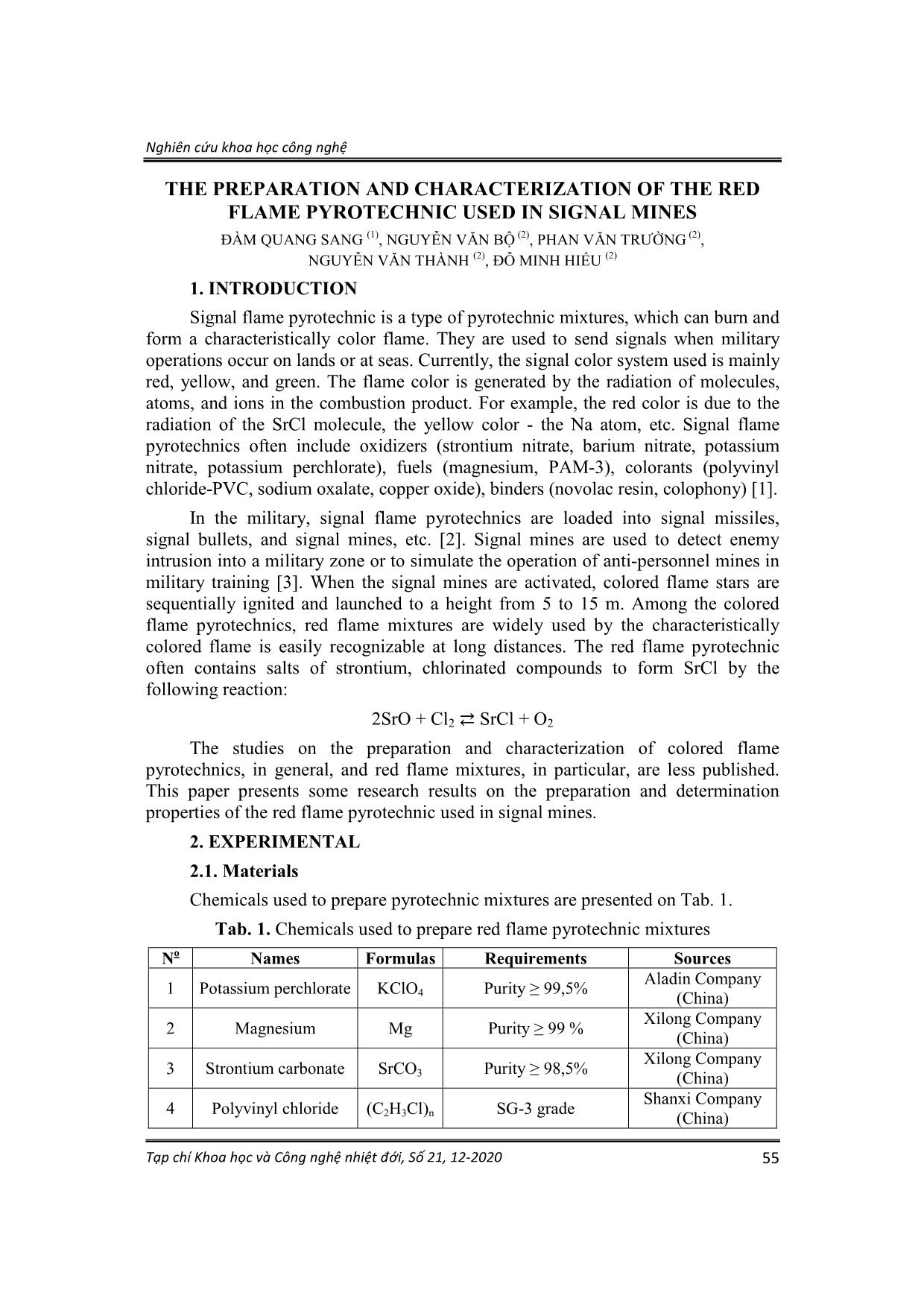
Trang 1
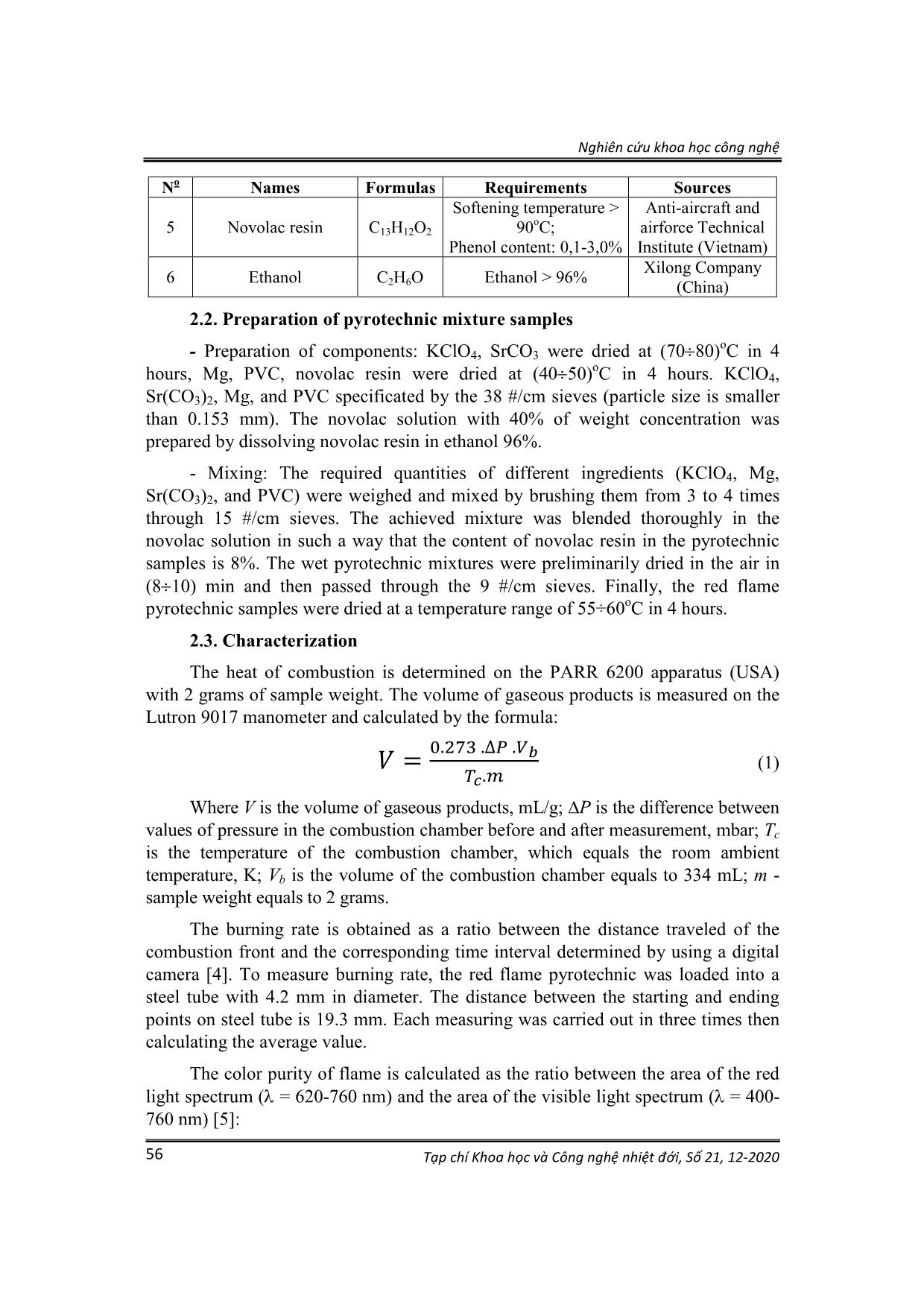
Trang 2
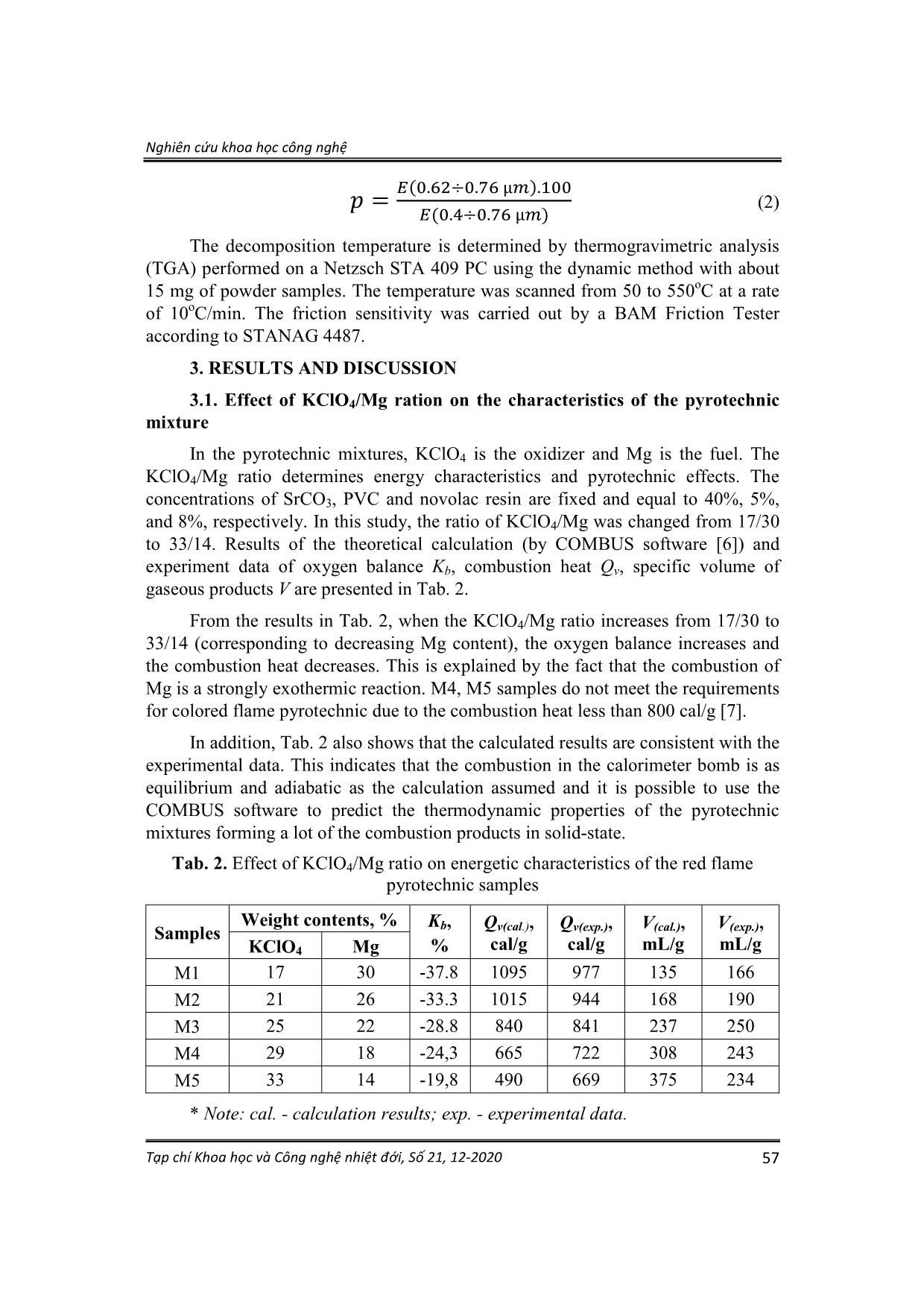
Trang 3
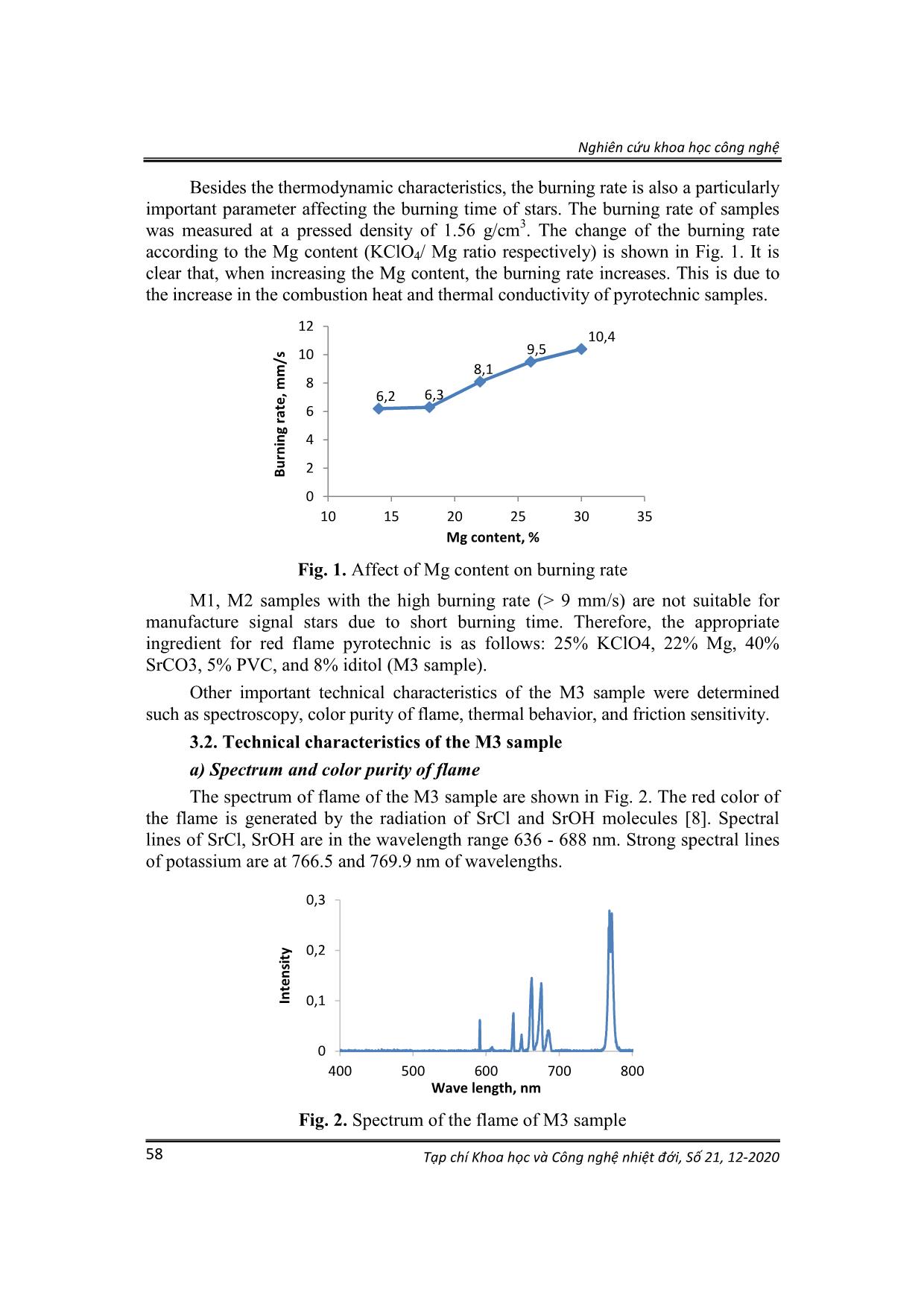
Trang 4
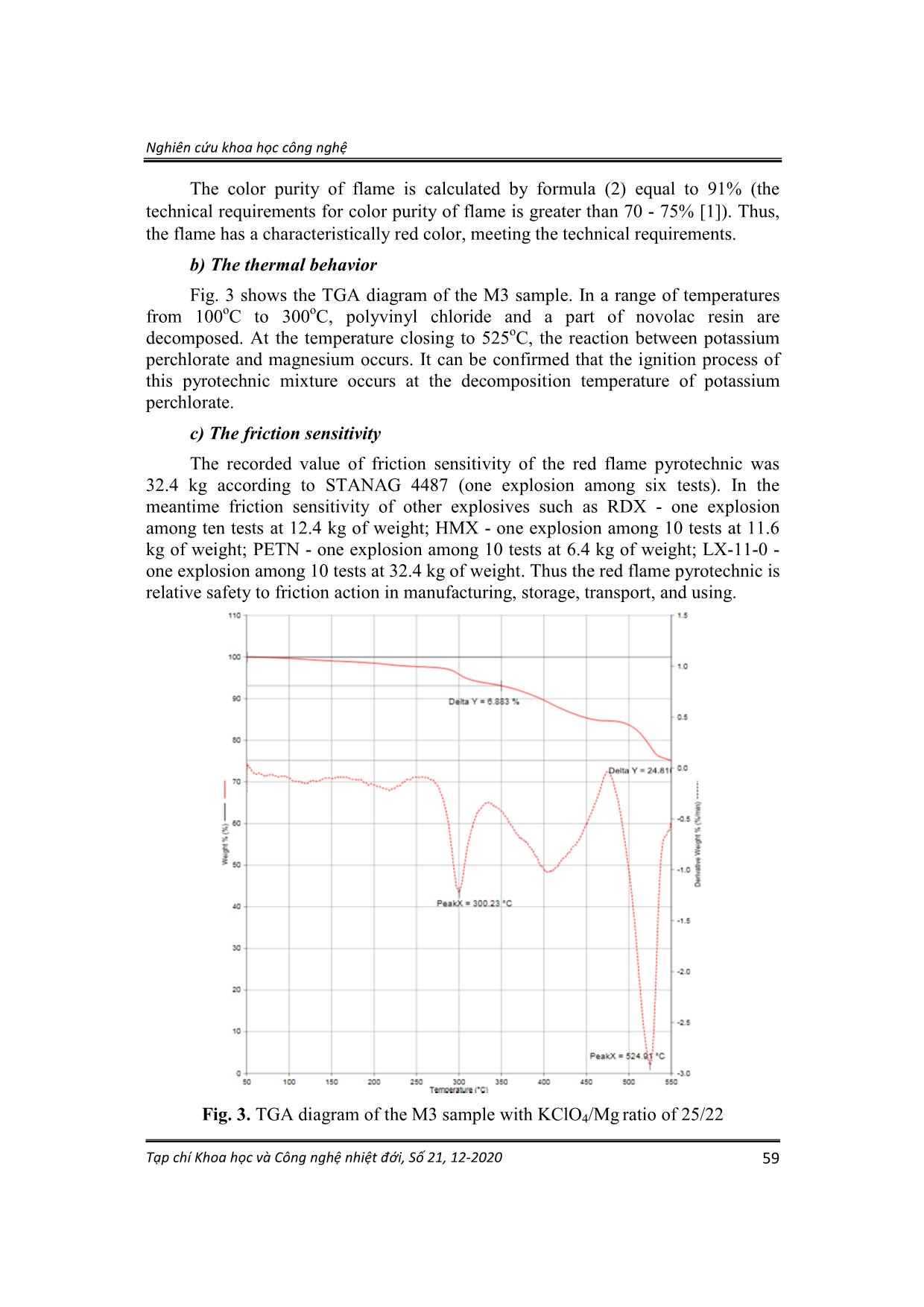
Trang 5
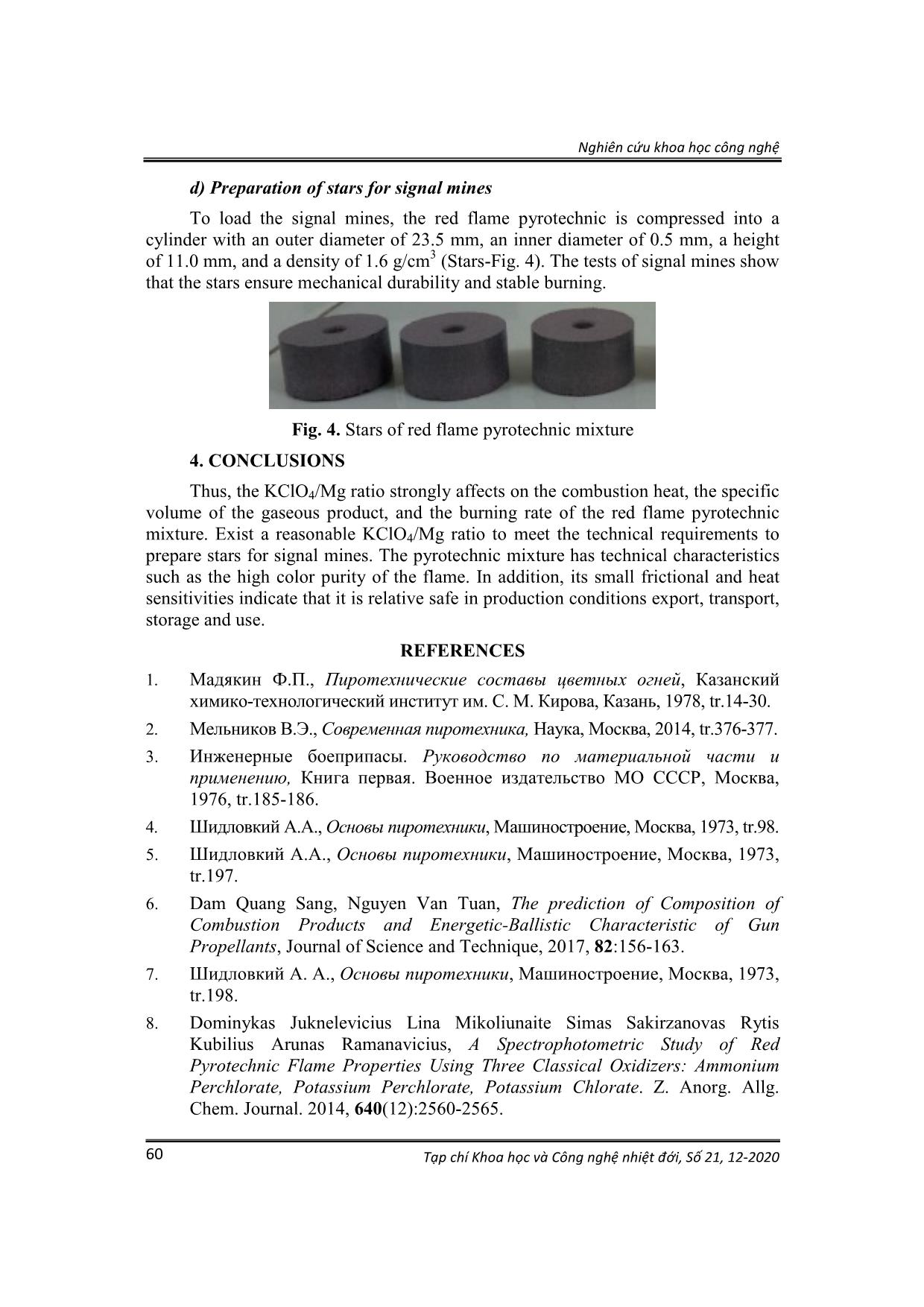
Trang 6
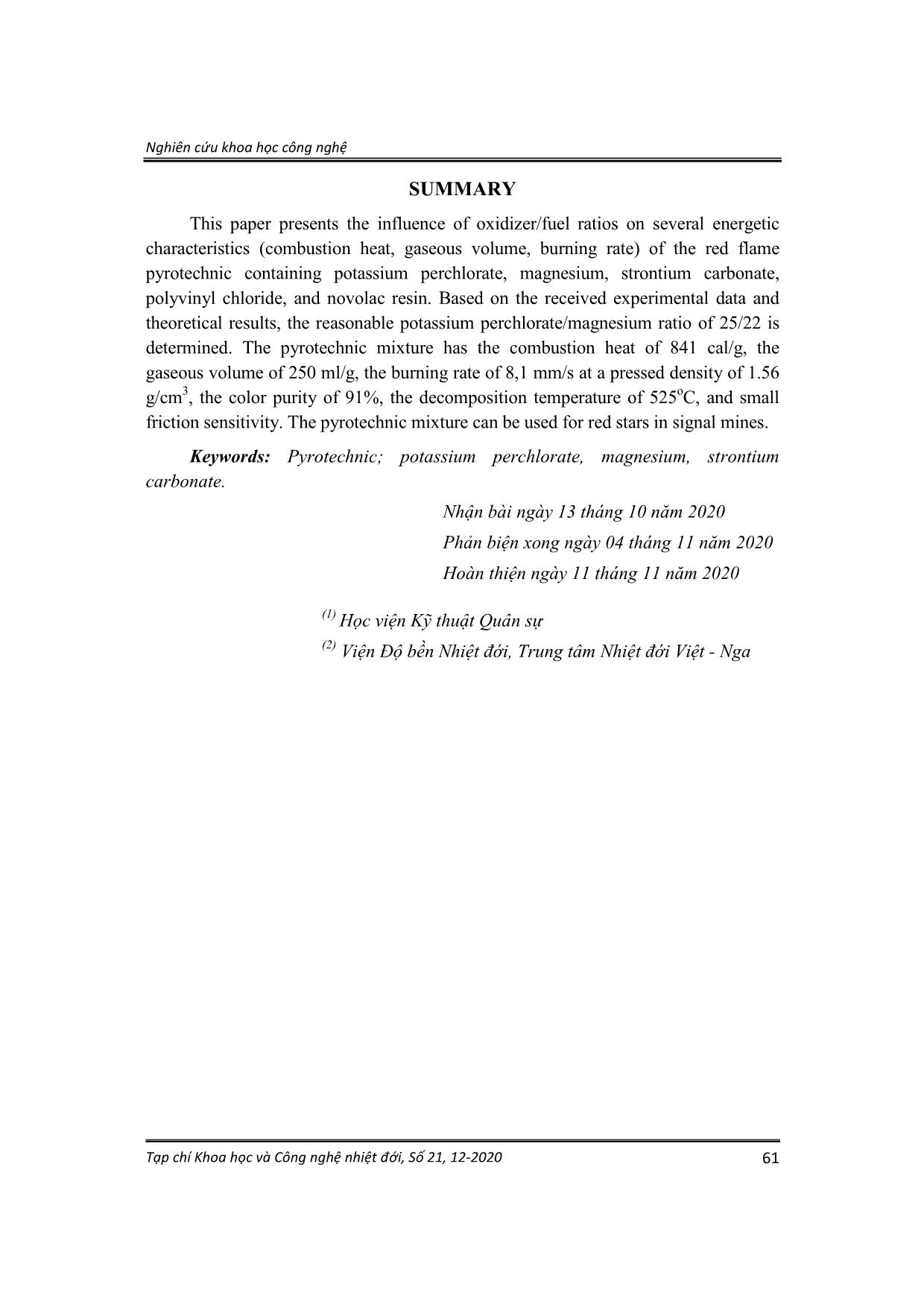
Trang 7
Tóm tắt nội dung tài liệu: The preparation and characterization of the red flame pyrotechnic used in signal mines

Nghiên cứu khoa học công nghệ Tạp chí Khoa học và Công nghệ nhiệt đới, Số 21, 12-2020 55 THE PREPARATION AND CHARACTERIZATION OF THE RED FLAME PYROTECHNIC USED IN SIGNAL MINES ĐÀM QUANG SANG (1), NGUYỄN VĂN BỘ (2), PHAN VĂN TRƯỜNG (2), NGUYỄN VĂN THÀNH (2), ĐỖ MINH HIẾU (2) 1. INTRODUCTION Signal flame pyrotechnic is a type of pyrotechnic mixtures, which can burn and form a characteristically color flame. They are used to send signals when military operations occur on lands or at seas. Currently, the signal color system used is mainly red, yellow, and green. The flame color is generated by the radiation of molecules, atoms, and ions in the combustion product. For example, the red color is due to the radiation of the SrCl molecule, the yellow color - the Na atom, etc. Signal flame pyrotechnics often include oxidizers (strontium nitrate, barium nitrate, potassium nitrate, potassium perchlorate), fuels (magnesium, PAM-3), colorants (polyvinyl chloride-PVC, sodium oxalate, copper oxide), binders (novolac resin, colophony) [1]. In the military, signal flame pyrotechnics are loaded into signal missiles, signal bullets, and signal mines, etc. [2]. Signal mines are used to detect enemy intrusion into a military zone or to simulate the operation of anti-personnel mines in military training [3]. When the signal mines are activated, colored flame stars are sequentially ignited and launched to a height from 5 to 15 m. Among the colored flame pyrotechnics, red flame mixtures are widely used by the characteristically colored flame is easily recognizable at long distances. The red flame pyrotechnic often contains salts of strontium, chlorinated compounds to form SrCl by the following reaction: 2SrO + Cl2 ⇄ SrCl + O2 The studies on the preparation and characterization of colored flame pyrotechnics, in general, and red flame mixtures, in particular, are less published. This paper presents some research results on the preparation and determination properties of the red flame pyrotechnic used in signal mines. 2. EXPERIMENTAL 2.1. Materials Chemicals used to prepare pyrotechnic mixtures are presented on Tab. 1. Tab. 1. Chemicals used to prepare red flame pyrotechnic mixtures No Names Formulas Requirements Sources 1 Potassium perchlorate KClO4 Purity ≥ 99,5% Aladin Company (China) 2 Magnesium Mg Purity ≥ 99 % Xilong Company (China) 3 Strontium carbonate SrCO3 Purity ≥ 98,5% Xilong Company (China) 4 Polyvinyl chloride (C2H3Cl)n SG-3 grade Shanxi Company (China) Nghiên cứu khoa học công nghệ Tạp chí Khoa học và Công nghệ nhiệt đới, Số 21, 12-2020 56 No Names Formulas Requirements Sources 5 Novolac resin C13H12O2 Softening temperature > 90oC; Phenol content: 0,1-3,0% Anti-aircraft and airforce Technical Institute (Vietnam) 6 Ethanol C2H6O Ethanol > 96% Xilong Company (China) 2.2. Preparation of pyrotechnic mixture samples - Preparation of components: KClO4, SrCO3 were dried at (7080)oC in 4 hours, Mg, PVC, novolac resin were dried at (4050)oC in 4 hours. KClO4, Sr(CO3)2, Mg, and PVC specificated by the 38 #/cm sieves (particle size is smaller than 0.153 mm). The novolac solution with 40% of weight concentration was prepared by dissolving novolac resin in ethanol 96%. - Mixing: The required quantities of different ingredients (KClO4, Mg, Sr(CO3)2, and PVC) were weighed and mixed by brushing them from 3 to 4 times through 15 #/cm sieves. The achieved mixture was blended thoroughly in the novolac solution in such a way that the content of novolac resin in the pyrotechnic samples is 8%. The wet pyrotechnic mixtures were preliminarily dried in the air in (810) min and then passed through the 9 #/cm sieves. Finally, the red flame pyrotechnic samples were dried at a temperature range of 55÷60oC in 4 hours. 2.3. Characterization The heat of combustion is determined on the PARR 6200 apparatus (USA) with 2 grams of sample weight. The volume of gaseous products is measured on the Lutron 9017 manometer and calculated by the formula: 𝑉 = .ଶଷ .∆ .್ ். (1) Where V is the volume of gaseous products, mL/g; ∆P is the difference between values of pressure in the combustion chamber before and after measurement, mbar; Tc is the temperature of the combustion chamber, which equals the room ambient temperature, K; Vb is the volume of the combustion chamber equals to 334 mL; m - sample weight equals to 2 grams. The burning rate is obtained as a ratio between the distance traveled of the combustion front and the corresponding time interval determined by using a digital camera [4]. To measure burning rate, the red flame pyrotechnic was loaded into a steel tube with 4.2 mm in diameter. The distance between the starting and ending points on steel tube is 19.3 mm. Each measuring was carried out in three times then calculating the average value. The color purity of flame is calculated as the ratio between the area of the red light spectrum ( = 620-760 nm) and the area of the visible light spectrum ( = 400- 760 nm) [5]: Nghiên cứu khoa học công nghệ Tạp chí Khoa học và Công nghệ nhiệt đới, Số 21, 12-2020 57 𝑝 = ா(.ଶ÷. µ).ଵ ா(.ସ÷. µ) (2) The decomposition temperature is determined by thermogravimetric analysis (TGA) performed on a Netzsch STA 409 PC using the dynamic method with about 15 mg of powder samples. The temperature was scanned from 50 to 550oC at a rate of 10oC/min. The friction sensitivity was carried out by a BAM Friction Tester according to STANAG 4487. 3. RESULTS AND DISCUSSION 3.1. Effect of KClO4/Mg ration on the characteristics of the pyrotechnic mixture In the pyrotechnic mixtures, KClO4 is the oxidizer and Mg is the fuel. The KClO4/Mg ratio determines energy characteristics and pyrotechnic effects. The concentrations of SrCO3, PVC and novolac resin are fixed and equal to 40%, 5%, and 8%, respectively. In this study, the ratio of KClO4/Mg was changed from 17/30 to 33/14. Results of the theoretical calculation (by COMBUS software [6]) and experiment data of oxygen balance Kb, combustion heat Qv, specific volume of gaseous products V are presented in Tab. 2. From the results in Tab. 2, when the KClO4/Mg ratio increases from 17/30 to 33/14 (corresponding to decreasing Mg content), the oxygen balance increases and the combustion heat decreases. This is explained by the fact that the combustion of Mg is a strongly exothermic reaction. M4, M5 samples do not meet the requirements for colored flame pyrotechnic due to the combustion heat less than 800 cal/g [7]. In addition, Tab. 2 also shows that the calculated results are consistent with the experimental data. This indicates that the combustion in the calorimeter bomb is as equilibrium and adiabatic as the calculation assumed and it is possible to use the COMBUS software to predict the thermodynamic properties of the pyrotechnic mixtures forming a lot of the combustion products in solid-state. Tab. 2. Effect of KClO4/Mg ratio on energetic characteristics of the red flame pyrotechnic samples Samples Weight contents, % Kb, % Qv(cal.), cal/g Qv(exp.), cal/g V(cal.), mL/g V(exp.), mL/g KClO4 Mg M1 17 30 -37.8 1095 977 135 166 M2 21 26 -33.3 1015 944 168 190 M3 25 22 -28.8 840 841 237 250 M4 29 18 -24,3 665 722 308 243 M5 33 14 -19,8 490 669 375 234 * Note: cal. - calculation results; exp. - experimental data. Nghiên cứu khoa học công nghệ Tạp chí Khoa học và Công nghệ nhiệt đới, Số 21, 12-2020 58 Besides the thermodynamic characteristics, the burning rate is also a particularly important parameter affecting the burning time of stars. The burning rate of samples was measured at a pressed density of 1.56 g/cm3. The change of the burning rate according to the Mg content (KClO4/ Mg ratio respectively) is shown in Fig. 1. It is clear that, when increasing the Mg content, the burning rate increases. This is due to the increase in the combustion heat and thermal conductivity of pyrotechnic samples. Fig. 1. Affect of Mg content on burning rate M1, M2 samples with the high burning rate (> 9 mm/s) are not suitable for manufacture signal stars due to short burning time. Therefore, the appropriate ingredient for red flame pyrotechnic is as follows: 25% KClO4, 22% Mg, 40% SrCO3, 5% PVC, and 8% iditol (M3 sample). Other important technical characteristics of the M3 sample were determined such as spectroscopy, color purity of flame, thermal behavior, and friction sensitivity. 3.2. Technical characteristics of the M3 sample a) Spectrum and color purity of flame The spectrum of flame of the M3 sample are shown in Fig. 2. The red color of the flame is generated by the radiation of SrCl and SrOH molecules [8]. Spectral lines of SrCl, SrOH are in the wavelength range 636 - 688 nm. Strong spectral lines of potassium are at 766.5 and 769.9 nm of wavelengths. Fig. 2. Spectrum of the flame of M3 sample 10,4 9,5 8,1 6,3 6,2 0 2 4 6 8 10 12 10 15 20 25 30 35 Bu rn in g ra te , m m /s Mg content, % 0 0,1 0,2 0,3 400 500 600 700 800 In te ns ity Wave length, nm Nghiên cứu khoa học công nghệ Tạp chí Khoa học và Công nghệ nhiệt đới, Số 21, 12-2020 59 The color purity of flame is calculated by formula (2) equal to 91% (the technical requirements for color purity of flame is greater than 70 - 75% [1]). Thus, the flame has a characteristically red color, meeting the technical requirements. b) The thermal behavior Fig. 3 shows the TGA diagram of the M3 sample. In a range of temperatures from 100oC to 300oC, polyvinyl chloride and a part of novolac resin are decomposed. At the temperature closing to 525oC, the reaction between potassium perchlorate and magnesium occurs. It can be confirmed that the ignition process of this pyrotechnic mixture occurs at the decomposition temperature of potassium perchlorate. c) The friction sensitivity The recorded value of friction sensitivity of the red flame pyrotechnic was 32.4 kg according to STANAG 4487 (one explosion among six tests). In the meantime friction sensitivity of other explosives such as RDX - one explosion among ten tests at 12.4 kg of weight; HMX - one explosion among 10 tests at 11.6 kg of weight; PETN - one explosion among 10 tests at 6.4 kg of weight; LX-11-0 - one explosion among 10 tests at 32.4 kg of weight. Thus the red flame pyrotechnic is relative safety to friction action in manufacturing, storage, transport, and using. Fig. 3. TGA diagram of the M3 sample with KClO4/Mg ratio of 25/22 Nghiên cứu khoa học công nghệ Tạp chí Khoa học và Công nghệ nhiệt đới, Số 21, 12-2020 60 d) Preparation of stars for signal mines To load the signal mines, the red flame pyrotechnic is compressed into a cylinder with an outer diameter of 23.5 mm, an inner diameter of 0.5 mm, a height of 11.0 mm, and a density of 1.6 g/cm3 (Stars-Fig. 4). The tests of signal mines show that the stars ensure mechanical durability and stable burning. Fig. 4. Stars of red flame pyrotechnic mixture 4. CONCLUSIONS Thus, the KClO4/Mg ratio strongly affects on the combustion heat, the specific volume of the gaseous product, and the burning rate of the red flame pyrotechnic mixture. Exist a reasonable KClO4/Mg ratio to meet the technical requirements to prepare stars for signal mines. The pyrotechnic mixture has technical characteristics such as the high color purity of the flame. In addition, its small frictional and heat sensitivities indicate that it is relative safe in production conditions export, transport, storage and use. REFERENCES 1. Мадякин Ф.П., Пиротехнические составы цветных огней, Казанский химико-технологический институт им. С. М. Кирова, Казань, 1978, tr.14-30. 2. Мельников В.Э., Современная пиротехника, Наука, Москва, 2014, tr.376-377. 3. Инженерные боеприпасы. Руководство по материальной части и применению, Книга первая. Военное издательство МО СССР, Москва, 1976, tr.185-186. 4. Шидловкий А.А., Основы пиротехники, Машиностроение, Москва, 1973, tr.98. 5. Шидловкий А.А., Основы пиротехники, Машиностроение, Москва, 1973, tr.197. 6. Dam Quang Sang, Nguyen Van Tuan, The prediction of Composition of Combustion Products and Energetic-Ballistic Characteristic of Gun Propellants, Journal of Science and Technique, 2017, 82:156-163. 7. Шидловкий А. А., Основы пиротехники, Машиностроение, Москва, 1973, tr.198. 8. Dominykas Juknelevicius Lina Mikoliunaite Simas Sakirzanovas Rytis Kubilius Arunas Ramanavicius, A Spectrophotometric Study of Red Pyrotechnic Flame Properties Using Three Classical Oxidizers: Ammonium Perchlorate, Potassium Perchlorate, Potassium Chlorate. Z. Anorg. Allg. Chem. Journal. 2014, 640(12):2560-2565. Nghiên cứu khoa học công nghệ Tạp chí Khoa học và Công nghệ nhiệt đới, Số 21, 12-2020 61 SUMMARY This paper presents the influence of oxidizer/fuel ratios on several energetic characteristics (combustion heat, gaseous volume, burning rate) of the red flame pyrotechnic containing potassium perchlorate, magnesium, strontium carbonate, polyvinyl chloride, and novolac resin. Based on the received experimental data and theoretical results, the reasonable potassium perchlorate/magnesium ratio of 25/22 is determined. The pyrotechnic mixture has the combustion heat of 841 cal/g, the gaseous volume of 250 ml/g, the burning rate of 8,1 mm/s at a pressed density of 1.56 g/cm3, the color purity of 91%, the decomposition temperature of 525oC, and small friction sensitivity. The pyrotechnic mixture can be used for red stars in signal mines. Keywords: Pyrotechnic; potassium perchlorate, magnesium, strontium carbonate. Nhận bài ngày 13 tháng 10 năm 2020 Phản biện xong ngày 04 tháng 11 năm 2020 Hoàn thiện ngày 11 tháng 11 năm 2020 (1) Học viện Kỹ thuật Quân sự (2) Viện Độ bền Nhiệt đới, Trung tâm Nhiệt đới Việt - Nga
File đính kèm:
 the_preparation_and_characterization_of_the_red_flame_pyrote.pdf
the_preparation_and_characterization_of_the_red_flame_pyrote.pdf

